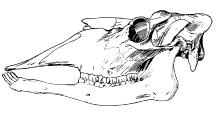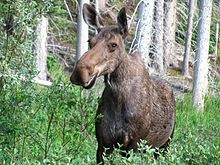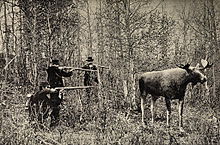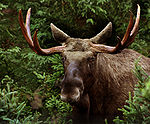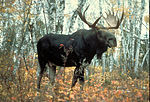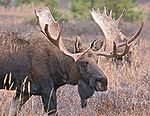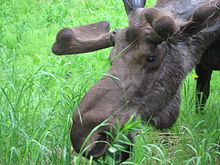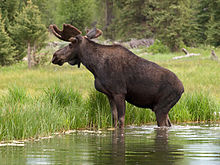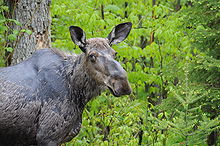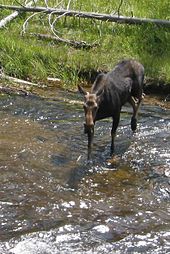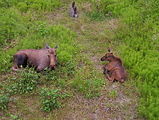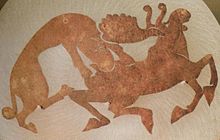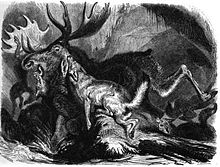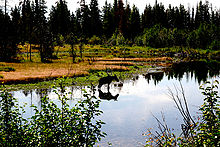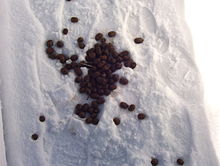- Moose
-
Moose 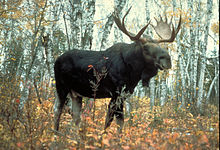
Male (bull) 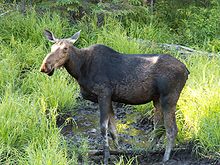
Female (cow) Conservation status Scientific classification Kingdom: Animalia Phylum: Chordata Class: Mammalia Order: Artiodactyla Family: Cervidae Subfamily: Capreolinae Genus: Alces
Gray, 1821Species: A. alces Binomial name Alces alces
(Linnaeus, 1758)
Moose range map The moose (North America) or Eurasian elk (Europe) (Alces alces) is the largest extant species in the deer family. Moose are distinguished by the palmate antlers of the males; other members of the family have antlers with a dendritic ("twig-like") configuration. Moose typically inhabit boreal and mixed deciduous forests of the Northern Hemisphere in temperate to subarctic climates. Moose used to have a much wider range but hunting and other human activities greatly reduced it over the years. Moose have been re-introduced to some of their former habitats. Their diet consists of both terrestrial and aquatic vegetation. The most common moose predators are wolves, bears, and humans. Unlike most other deer species, moose are solitary animals and do not form herds. Although generally slow-moving and sedentary, moose can become aggressive and move surprisingly fast if angered or startled. Their mating season in the autumn can lead to spectacular fights between males competing for the right to mate with a particular female.
Contents
Etymology and naming
The animal bearing the scientific name Alces alces is known in Britain as the elk,[2] and in North America as the moose.
The British English word elk has cognates in other Indo-European languages, for example elg in Norwegian, älg in Swedish, Elch in German and łoś in Polish. Confusingly, the word elk is used in North America to refer to a different animal, Cervus canadensis, also known as the wapiti which is similar though slightly smaller (the wapiti is the second largest deer species), and behaviorally divergent from the smaller red deer of central and western Europe. Presumably early European explorers in North America called it elk because of its size and presumably because, as men coming from the British Isles they would have had no opportunity to see the difference between a member of the genus Cervus and an animal fitting the description of Alces at home, where the latter was nowhere present in the 17th and 18th century.
The word "moose" first entered English by 1606,[3] and is a borrowing from Algonquian languages (compare Narragansett moos and Eastern Abenaki mos, according to early sources likely derived from moosu meaning "he strips off"),[4] possibly involving forms from multiple languages mutually reinforcing one another. The Proto-Algonquian form was *mo·swa.[5]
A mature male moose is called a bull moose,[6] a mature female moose is called a cow moose,[7] and an immature moose of either sex is called a (moose) calf.[8]
Habitat, range, and distribution
North America
In North America, the moose range includes almost all of Canada (excluding the arctic), most of Alaska, northern New England and upstate New York, the upper Rocky Mountains, northeastern Minnesota, Michigan's Upper Peninsula, and Isle Royale in Lake Superior. Within this massive range, the most diverse range of subspecies exist, containing habitat for four of the six subspecies. In western portions of the continent, moose populations extend well north into Canada (British Columbia and Alberta) and more isolated groups have been verified as far south as the mountains of Utah and Colorado and as far west as the Lake Wenatchee area of the Washington Cascades.[9][10][11] In 1978, a few breeding pairs were reintroduced in western Colorado, and the state's moose population is now more than 1,000 with great potential to grow.
In Northeastern North America, the Eastern moose's history is very well documented: moose meat was often a staple in the diet of Native Americans going back centuries and it is a tribe that occupied present day coastal Rhode Island that gave this deer its distinctive name in American English. The Native Americans often used moose hides for leather and its meat as an ingredient in pemmican, a type of dried jerky used as a source of sustenance in winter or on long journeys from home.[12] Eastern tribes also valued moose leather as a source to make moccasins and other decorations.
The historical range of the subspecies extended from well into Quebec, the Maritimes, and Eastern Ontario south to include all of New England finally ending in the very northeastern tip of Pennsylvania in the west, cutting off somewhere near the mouth of the Hudson River in the east. Within the eastern U.S. it has up until recently been extirpated for up to a hundred fifty years or more, due to colonial era overhunting and destruction of its habitat: Dutch, French, and British colonial sources all attest to its presence in the mid 17th century from Maine south to areas within a hundred miles of present day Manhattan. However, by the 1870s, only a handful of them existed in this entire region in very remote pockets of forest; less than 20% of suitable habitat remained.
Between the 1980s to 2010s, however, this has changed dramatically, predicated on the regrowth of plentiful food sources, abandonment of farmland, better land management, cleanup of pollution and natural dispersal from the Canadian Maritimes and Quebec. South of the Canadian border Maine has the most of the population with a current headcount of about 30,000 moose and dispersals from Maine over the years have resulted in healthy, growing populations each in Vermont and New Hampshire, notably near bodies of water and as high up as 3,000 feet above sea level in the mountains. In turn dispersals from northern New England have resulted in a growing population of roughly 1,000 moose in Massachusetts (where it has been absent since the early 18th century) plus reports of new dispersals to eastern New York, Rhode Island, and Connecticut.[13][14][15][16][17][18][19]
Moose were successfully introduced on Newfoundland in 1878 and 1904[20] where they are now the dominant ungulate, and somewhat less successfully on Anticosti Island in the Gulf of St. Lawrence.
Europe
In Europe, moose are currently found in large numbers throughout Norway, Sweden, Finland, Poland, and the Baltic States, with more modest numbers in the southern Czech Republic, Belarus and northern Ukraine. They are also widespread through Russia on up through the borders with Finland south towards the border with Estonia, Belarus and Ukraine and stretching far away eastwards to the Yenisei River in Siberia. The European moose was native to most temperate areas that it could physically inhabit on the continent and even Scotland from the end of the last Ice Age as Europe's traditional habitat had a natural mix of temperate boreal and deciduous forest. It was certainly thriving in both Gaul and Magna Germania as it appears in military and hunting accounts of the age. However, as the Roman era faded into medieval times, the beast slowly disappeared: it survived in Alsace and the Netherlands until the 9th century as the marshlands in the latter were drained and the forests were being cleared away for feudal lands in the former. It was gone from Switzerland by 1000 AD, gone from the western Czech Republic by 1300, gone from Mecklenburg in Germany by c. 1600, and has been gone from Hungary and the Caucasus since the 18th and 19th century respectively.
By the early 20th century the very last strongholds of the European moose appeared to be in Scandinavian countries and patchy tracts of Russia. The USSR and Poland managed to restore portions of the range within its borders (such as the 1951 reintroduction into Kampinos National Park and the later 1958 reintroduction in Belarus) but political complications obviously limited its ability to be reintroduced to other portions of its range. Attempts in 1930 and again in 1967 in marshland north of Berlin were unsuccessful. At present in Poland populations are recorded in the Biebrza river valley, Kampinos, and in Białowieża National Park. Overall it is recorded as a migrant into other parts of Eastern Europe and has been spotted in Eastern and Southern Germany.[21] Unsuccessful thus far in recolonizing these areas via natural dispersal from source populations in Poland, Belarus, Ukraine, Czech Republic and Slovakia, it appears to be having more success migrating south into the Caucasus. It is listed under Appendix III of the Bern Convention.[22][23]
In 2008, two moose were reintroduced into the Scottish Highlands[24][25] in Alladale Wilderness Reserve.[26]
New Zealand
In 1900 an attempt to introduce moose into the Hokitika area failed and ten moose, four bulls and six cows, were introduced into Fiordland in 1910. The last proven sighting of a moose in New Zealand was in 1952.[27] A moose antler was found in 1972 and DNA tests showed that hair collected in 2002 was from a moose. Extensive searching has been carried out and while automated cameras failed to capture photographs, evidence was seen of bedding spots, browsing and antler marks.[28]
Populations
Russia: In 2008, there were approximately 730,000 moose.[citation needed]
Finland: In 2009, there was a summer population of 115,000 moose.[29]
Sweden: The summer population is 300,000–400,000 moose. 100,000 are shot each fall.[30][31]
Norway: In 2007, there were some 120,000 moose.[citation needed]
Canada: There are an estimated 500,000 to 1,000,000 moose [32] with 150,000 in Newfoundland in 2007 descended from just four that were introduced in the 1900s.[33]
United States: probably around 300,000, as follows:
- Northeast: A wildlife ecologist estimated 50,000 in New York State and New England in 2007.[34]
- Upper Midwest: Michigan estimated 433 (in its Upper Peninsula) in 2011,[35] Wisconsin Department of Natural Resources 20-40 (close to its UP border with Michigan) in 2003, Minnesota 5600 in its northeast in 2010,[36] and under 100 in its northwest in 2009;[37] North Dakota closed, due to low moose population, one of its moose-hunting (geographic) units in 2011, and issued 162 single-kill licenses to hunters, each restricted to one of the remaining nine units.[38]
- Rocky Mountain states: Wyoming is said to have the largest share in its 6-state region, and its Fish and Game Commission estimated 7,692 in 2009.[39]
- Alaska: The state's Department of Fish and Game estimated 200,000 in 2011.[40]
Subspecies
Eurasian Elk A. a. alces Finland, Sweden, Norway, Estonia, and Russia. No longer present in central and western Europe except for Poland, Lithuania and Belarus, with a certain population in the Czech Republic, Slovakia and northern Ukraine, but can be observed in Bohemia since the 1970s and a tiny reintroduced population in Scotland, Great Britain. (Range formerly included France, Germany, Switzerland, and Benelux nations.) Eastern Moose A. a. americana Eastern Canada, including eastern Ontario, all of Quebec, and the Maritime Provinces. Northeastern United States including Maine, New Hampshire, Vermont, Massachusetts, Rhode Island, Connecticut, and northern New York State near the Adirondack Mountains. Population increasing. Western Moose A. a. andersoni British Columbia to western Ontario, eastern Yukon, Northwest Territories, southwestern Nunavut, Michigan (Upper Peninsula), northern Wisconsin, northern Minnesota, and northeastern North Dakota. Siberian Moose A. a. cameloides eastern Siberia, Mongolia, and Manchuria. Mostly found in forests of eastern Russia; believed extirpated from China and Korean Peninsula. Alaska Moose A. a. gigas Alaska and western Yukon. Largest subspecies and largest deer on earth. Shiras Moose A. a. shirasi Wyoming, Idaho, Utah, Colorado, Washington, Oregon, and Montana.[41] Smallest subspecies. † Caucasian Moose A. a. caucasicus Caucasus Mountains. Extinct due to loss of habitat and overhunting. Range would have included Iran, Russia, Georgia, Azerbaijan, and Turkey. Biology and behavior
Diet
The moose is a herbivore and is capable of consuming many types of plant or fruit. The average adult moose needs to consume 9770 Calories per day to maintain its body weight.[42] Much of a moose's energy is derived from terrestrial vegetation, mainly consisting of forbs and other non-grasses, and fresh shoots from trees such as willow and birch. These plants are rather low in sodium, and moose generally need to consume a good quantity of aquatic plants. While much lower in energy, these plants provide the moose with its sodium requirements, and as much as half of their diet usually consists of aquatic plant life.[43] In winter, moose are often drawn to roadways, to lick salt that is used as a snow and ice melter.[44] A typical moose, weighing 360 kilograms, can eat up to 32 kg of food per day.[43]
Moose lack upper front teeth, but have eight sharp incisors on the lower jaw. They also have a tough tongue, lips and gums, which aid in the eating of woody vegetation. Moose have six pairs of molars and, ahead of those, six pairs of premolars, to grind up their food. A moose's diet often depends on its location, but they seem to prefer the new growths from trees such as white birch, trembling aspen and striped maple, among many others. Many aquatic plants include lilies and pondweed.[45] Moose are excellent swimmers and are known to wade into water to eat aquatic plants. In non polar regions this trait serves a second purpose in cooling down the moose on summer days and ridding itself of black flies. Moose are thus attracted to marshes and river banks during warmer months as both provide suitable vegetation to eat and water to wet themselves in.
Antlers
The male's antlers grow as cylindrical beams projecting on each side of the head at right angles to the midline of the skull, and then fork. The lower prong of this fork may be either simple, or divided into two or three tines, with some flattening.
In the North Siberian elk (A. a. bedfordiae), the posterior division of the main fork divides into three tines, with no distinct flattening. In the common elk (A. a. alces) this branch usually expands into a broad palmation, with one large tine at the base, and a number of smaller snags on the free border. There is, however, a Scandinavian breed of the common elk in which the antlers are simpler, and recall those of the East Siberian animals.
The palmation appears to be more marked in North American moose (A. a. americanus) than in the typical Scandinavian elk.
The male will drop its antlers after the mating season and conserve energy for the winter. A new set of antlers will then regrow in the spring. Antlers take three to five months to fully develop, making them one of the fastest growing animal organs. They initially have a layer of skin, called "velvet," which is shed once the antlers become fully grown. Immature bulls may not shed their antlers for the winter, but retain them until the following spring.
If a bull moose is castrated, either by accidental or chemical means, he will quickly shed his current set of antlers and then immediately begin to grow a new set of misshapen and deformed antlers that he will wear the rest of his life without ever shedding again. The distinctive looking appendages (often referred to as "devil's antlers") are the source of several myths and legends among many groups of Inuit as well as several other tribes of indigenous peoples of North America.[46]
In extremely rare circumstances a cow moose may grow antlers. This is usually attributed to a hormone imbalance.[47]
Size and weight
On average, an adult moose stands 1.8–2.1 m (6–7 ft) high at the shoulder.[48] Males weigh 380–720 kg (850–1580 pounds) and females weigh 270–360 kg (600–800 pounds).[49] The largest of all is the Alaskan subspecies (A. a. gigas), which can stand over 2.1 m (7 ft) at the shoulder, has a span across the antlers of 1.8 m (6 ft) and averages 634.5 kg (1,396 lbs) in males and 478 kg (1,052 lbs) in females.[50] Typically, however, the antlers of a mature specimen are between 1.2 m (3.9 ft) and 1.5 m (4.9 ft). The largest confirmed size for this species was a bull shot at the Yukon River in September 1897 weighing 820 kg (1,800 lb) and was 233 cm (92 in) tall at the shoulder.[51] The Moose of Alaska matches the extinct Irish Elk as the largest deer of all time.[52] Behind only the bison, the Moose is the second largest land animal in both North America and Europe. The life span of an average moose is about 15–25 years.
Social structure and reproduction
Moose are mostly diurnal. They are generally solitary with the strongest bonds between mother and calf. Although moose rarely gather in groups, there may be several in close proximity during the mating season.
Mating occurs in September and October. The males are polygamous and will seek several females to breed with. During this times both sexes will call to each other. Males produce heavy grunting sounds that can be heard from up to 500 meters away, while females produce wail-like sounds.[53] Males will fight for access to females. They either assess which is larger, with the smaller bull retreating, or they may engage in battles, usually only involving the antlers.
Female moose have an eight-month gestation period, usually bearing one calf, or twins if food is plentiful,[54] in May or June.[55] Newborn moose have fur with a reddish hue in contrast to the brown appearance of an adult. The young will stay with the mother until just before the next young are born.
Aggression
Moose are not usually aggressive towards humans, but can be provoked or frightened to behave with aggression. In terms of raw numbers, they attack more people than bears and wolves combined, but usually with only minor consequences. When harassed or startled by people or in the presence of a dog, moose may charge. Also, as with bears or any wild animal, moose that have become habituated to being fed by people may act aggressively when denied food. During the fall mating season, bull moose may be aggressive toward humans due to the high hormone levels they experience. Cows with young calves are very protective and will attack humans who come too close, especially if they come between mother and calf. Unlike other dangerous animals, moose are not territorial, and do not view humans as food, and will therefore usually not pursue humans if they simply run away.[56] Like any wild animal, moose are unpredictable and should be given a respectful amount of space.
Natural predators
A full-grown moose has few enemies, but a pack of wolves can still pose a threat, especially to females with calves.[57] Siberian Tigers[58] and Brown bear[50] are also known to prey on moose, although bears are more likely to take over a wolf kill or to take young moose than to hunt adult moose on their own.[59] American black bears and cougars can be significant predators of moose calves in May and June.[60][61] Killer Whales are the moose's only known marine predator as they have been known to prey on them when swimming between islands out of North America's Northwest Coast.[62]
In some areas, moose are the primary source of food for wolves. Moose usually flee upon detecting wolves. Wolves usually follow moose at a distance of 100 to 400 metres (330 to 1,300 ft), occasionally at a distance of 2 to 3 kilometres (1.2 to 1.9 mi). Attacks from wolves against young moose may last seconds, though sometimes they can be drawn out for days with adults. Sometimes, wolves will chase moose into shallow streams or onto frozen rivers, where their mobility is greatly impeded. Moose will sometimes stand their ground and defend themselves by charging at the wolves or lashing out at them with their powerful hooves. Wolves typically kill moose by tearing at their haunches and perineum, causing massive blood loss. Occasionally, a wolf may immobilise a moose by biting its sensitive nose, the pain of which can paralyze a moose.[63] Wolf packs primarily target calves and elderly animals, but can and will take healthy, adult moose. Moose between the ages of two and eight are rarely killed by wolves.[64] Though moose are usually hunted by packs, there are cases in which single wolves have successfully killed moose.[65]
Relationship with humans
History
European rock drawings and cave paintings reveal that moose have been hunted since the Stone Age. Excavations in Alby, Sweden, adjacent to the Stora Alvaret have yielded elk antlers in wooden hut remains from 6000 BC, indicating some of the earliest elk hunting in northern Europe. In northern Scandinavia one can still find remains of trapping pits used for hunting elk. These pits, which can be up to 4 × 7 m wide and 2 m deep, would have been camouflaged with branches and leaves. They would have had steep sides lined with planks, making it impossible for the elk to escape once it fell in. The pits are normally found in large groups, crossing the elk's regular paths and stretching over several kilometres. Remains of wooden fences designed to guide the animals toward the pits have been found in bogs and peat. In Norway, an early example of these trapping devices has been dated to around 3,700 BC. Trapping elk in pits is an extremely effective hunting method, and as early as the 16th century the Norwegian government tried to restrict their use. Nevertheless, the method was in use until the 19th century.
The earliest recorded description of the elk is in Julius Caesar's Commentarii de Bello Gallico, where it is described thus:
- "There are also [animals], which are called elks. The shape of these, and the varied colour of their skins, is much like roes, but in size they surpass them a little and are destitute of horns, and have legs without joints and ligatures; nor do they lie down for the purpose of rest, nor, if they have been thrown down by any accident, can they raise or lift themselves up. Trees serve as beds to them ; they lean themselves against them, and thus reclining only slightly, they take their rest; when the huntsmen have discovered from the footsteps of these animals whither they are accustomed to betake themselves, they either undermine all the trees at the roots, or cut into them so far that the upper part of the trees may appear to be left standing. When they have leant upon them, according to their habit, they knock down by their weight the unsupported trees, and fall down themselves along with them."[66]
In book 8, chapter 16 of Pliny the Elder's Natural History from 77 AD the elk and an animal called achlis, which is presumably the same animal, are described thus:
- "...there is, also, the elk, which strongly resembles our steers, except that it is distinguished by the length of the ears and of the neck. There is also the achlis, which is produced in the land of Scandinavia; it has never been seen in this city, although we have had descriptions of it from many persons; it is not unlike the elk, but has no joints in the hind leg. Hence, it never lies down, but reclines against a tree while it sleeps; it can only be taken by previously cutting into the tree, and thus laying a trap for it, as otherwise, it would escape through its swiftness. Its upper lip is so extremely large, for which reason it is obliged to go backwards when grazing; otherwise, by moving onwards, the lip would get doubled up."[67]
As food
Moose are hunted as a game species in many of the countries where they are found. Moose meat tastes, wrote Henry David Thoreau in “The Maine Woods”, “like tender beef, with perhaps more flavour; sometimes like veal”. While the flesh has protein levels similar to other comparable red meats (e.g. beef, deer and elk) it has a low fat content and the fat that is found is made up of a higher proportion of polyunsaturated fats (rather than saturated fats).[68]
Cadmium levels are high in Finnish elk liver and kidneys, with the result that consumption of these organs from elk more than one year old is prohibited in Finland.[69] Cadmium intake has been found to be elevated amongst all consumers of elk meat, though the elk meat was found to contribute only slightly to the daily cadmium intake. However the consumption of moose liver or kidneys significantly increased cadmium intake, with the study revealing that heavy consumers of moose organs have a relatively narrow safety margin below the levels which would probably cause adverse health effects.[70]
Dr. Valerius Geist, who emigrated to Canada from the Soviet Union, wrote in his 1999 book Moose: Behaviour, Ecology, Conservation:
Those who care most passionately about moose are—paradoxically—hunters, in particular people who live in wilderness and rural communities and those who depend on moose for food. In Sweden, no fall menu is without a mouthwatering moose dish. The Swedes fence their highways to reduce moose fatalities and design moose-proof cars. Sweden is less than half as large as the Canadian province of British Columbia, but the annual take of moose in Sweden—upward of 150,000—is twice that of the total moose harvest in North America. That is how much Swedes cherish their moose.
Boosting of moose populations in Alaska for hunting purposes is one of the reasons given for allowing aerial or airborne methods to remove wolves in designated areas, e.g., Craig Medred: "A kill of 124 wolves would thus translate to [the survival of] 1488 moose or 2976 caribou or some combination thereof".[71] Many scientists believe that this artificial inflation of game populations is actually detrimental to both caribou and moose populations as well as the ecosystem as a whole. This is because studies have shown that when these game populations are artificially boosted, it leads to both habitat destruction and a crash in these populations[72]
Vehicle collisions
A moose's body structure, with a large heavy body suspended on long spindly legs, makes these animals particularly dangerous when hit by passenger cars with low ground clearances. Generally, when colliding with a moose at high speed, the car's bumper and front grille will break the moose's legs, causing the body of the moose to fall onto the car's hood and delivering the bulk of the animal's weight into the windshield, crushing the front roof support beams and anyone in the front seats.[73] Collisions of this type are frequently lethal; seatbelts offer no protection, and airbags may not deploy or be of much use if they do.[74] Although vehicles with higher clearances (such as trucks) are typically immune from this effect, the force of striking any 270+ kg (600+ pound) object at high speed should not be underestimated. These risks led to the development of a vehicle test referred to as the "moose test" (Swedish: Älgtest, German: Elchtest).
Kaliforsky Beach Road, Kenai, Alaska, trees and brush are trimmed along high moose crossing areas so that moose can be seen as they approach the road
Moose warning signs are used on roads in regions where there is a danger of collision with the animal. The triangular warning signs common in Sweden, Norway, and Finland have become coveted souvenirs among tourists traveling in these countries, causing the road authorities so much expense that the moose signs have been replaced with image-less generic warning signs in some regions.[75]
Norwegian newspaper Aftenposten estimated in January 2008 that some 13,000 moose had died in collisions with Norwegian trains since 2000. The state agency in charge of railroad infrastructure (Jernbaneverket) plans to spend 80 million Norwegian kroner to reduce collision rate in the future by fencing the railways, clearing vegetation from near the tracks, and providing alternative snow-free feeding places for the animals elsewhere.[76]
In the Canadian province of New Brunswick, collisions with moose are frequent enough that all new highways have fences to prevent moose from accessing the road, similar to how it has long been done in Finland, Norway, and Sweden. Demonstratively, Highway 7 between Fredericton and Saint John, which has one of the highest frequencies of moose collisions in the province, did not have these fences until 2008, although it was and continues to be extremely well signed.[77][78] In Newfoundland and Labrador, it is recommended to motorists to use caution between dusk and dawn, because that is when moose are most active and most difficult to see, increasing the risk of collisions.[79] Local moose sightings are often reported on radio stations so that motorists can take care while driving in particular areas.
In Sweden a fence will not be placed unless the road meets the minimum requirement of one accident, involving a moose, per kilometre road and year.[80]
Domestication
Domestication of moose was investigated in the Soviet Union before World War II. Early experiments were inconclusive, but with the creation of a moose farm at Pechora-Ilych Nature Reserve in 1949 a small-scale moose domestication program was started, involving attempts at selective breeding of animals based on their behavioural characteristics. Since 1963, the programme has continued at Kostroma Moose Farm, which had a herd of 33 tame moose as of 2003. Although at this stage the farm is not expected to be a profit-making enterprise, it obtains some income from the sale of moose milk and from visiting tourist groups. Its main value, however, is seen in the opportunities it offers for the research in the physiology and behaviour of the moose, as well as in the insights it provides into the general principles of animal domestication.
In Sweden there was a debate in the late 18th century about the national value of using the moose as a domestic animal. Among other things, the moose was proposed to be used in postal distribution, and there was a suggestion to develop a moose-mounted cavalry. Such proposals remained unimplemented, mainly because the extensive hunting for moose nearly drove it to extinction[81] and because of moose aggressiveness during the rutting period.
References
- ^ Henttonen, H., Stubbe, M., Maran, T. & Tikhonov A. (2008). Alces alces. In: IUCN 2008. IUCN Red List of Threatened Species. Downloaded on 11 February 2009.
- ^ "elk, n.1". Oxford English Dictionary. http://www.oed.com/view/Entry/60507. Retrieved 15 December 2010.
- ^ "moose". Oxford English Dictionary. Oxford University Press. 2nd ed. 1989.
- ^ Template:OEtmD
- ^ "moose". Dictionary.com Unabridged. Random House, Inc. http://dictionary.reference.com/browse/moose. Retrieved 2011-10-25.
- ^ or less frequently a moose bull
- ^ or less frequently a moose cow
- ^ or less frequently a calf moose
- ^ "Utah Division of Wildlife Resources". Wildlife.utah.gov. 2006-04-28. Archived from the original on October 5, 2007. http://web.archive.org/web/20071005181422/http://www.wildlife.utah.gov/news/06-04/permits.php. Retrieved 2009-11-27.
- ^ "Oregon moose population is booming". The Seattle Times. 2006-08-21. http://seattletimes.nwsource.com/html/nationworld/2003215177_webmoose21.html.
- ^ [1][dead link]
- ^ Nancy Cappelloni (November 2002). Cranberry Cooking for All Seasons. Spinner Publications. pp. 14–. ISBN 9780932027719. http://books.google.com/books?id=u-uomE8l8g8C&pg=PA14. Retrieved 25 June 2011.
- ^ Living With Moose. Mass.gov (2007-09-20). Retrieved on 2011-01-09.
- ^ Maine Department of Inland Fisheries and Wildlife – Moose Hunting Permits. Maine.gov. Retrieved on 2011-01-09.
- ^ Connecticut Wildlife Sep/Oct 2004. (PDF). Retrieved on 2011-01-09.
- ^ Moose are on the Loose|Connecticut Public Broadcasting Network. Cpbn.org. Retrieved on 2011-01-09.
- ^ Forests lure moose to Massachusetts / The Christian Science Monitor. CSMonitor.com (2007-02-14). Retrieved on 2011-01-09.
- ^ Moose in a Mess? – Defenders of Wildlife. Defenders.org. Retrieved on 2011-01-09.
- ^ Moose – NYS Dept. of Environmental Conservation. Dec.ny.gov (1999-07-06). Retrieved on 2011-01-09.
- ^ Moose, Newfoundland Costal Safari
- ^ Schnfeld, Fiona (2009). "Presence of moose (Alces alces) in Southeastern Germany". European Journal of Wildlife Research 55: 449. doi:10.1007/s10344-009-0272-5.
- ^ Alces alces (Eurasian Elk, Moose, Elk, Eurasian Moose, European Elk, Siberian Elk). Iucnredlist.org. Retrieved on 2011-01-09.
- ^ Wayward elk ‘Knutschi’ found dead – The Local. Thelocal.de. Retrieved on 2011-01-09.
- ^ 24 april 2009 (2009-04-24). "Re-Introducing Moose to the Glen – Moose – BBC". YouTube. http://www.youtube.com/watch?v=Euq1KEgysKg. Retrieved 2009-11-27.
- ^ Auslan Cramb; Paul Eccleston (14 April 2008). "Moose to roam free again in Scotland". The Telegraph. http://www.telegraph.co.uk/earth/earthnews/3339404/Moose-to-roam-free-again-in-Scotland.html. Retrieved 7 August 2011.
- ^ "European Elk - Alces alces". alladale.com. Alladale Wilderness Reserve. http://www.alladale.com/wilderness-reserve/highland-flora--fauna/european-elk---alces-alces.html. Retrieved 7 August 2011.
- ^ "Deer and deer farming – Introduction and impact of deer". Te Ara – Encyclopedia of New Zealand. 1 March 2009. http://www.teara.govt.nz/en/deer-and-deer-farming/1. Retrieved 27 March 2011.
- ^ "Hairs move NZ moose out of realm of Nessie – 06 October 2005 – Dunedin and Otago News, Sport and Weather from NZ Herald". NZ Herald. 2005-10-06. http://www.nzherald.co.nz/location/story.cfm?l_id=141&ObjectID=10348890. Retrieved 2009-11-27.
- ^ RiistaWeb. Riistaweb.riista.fi. Retrieved on 2011-01-09.
- ^ "jagareforbundet.se". jagareforbundet.se. http://www.jagareforbundet.se/Viltet/ViltVetande/Artpresentationer/Alg/. Retrieved 2011-02-16.
- ^ salenalgen.se Om älgar (in Swedish)
- ^ "Hinterland Who's Who Retrieved on 2011-01-12". Hww.ca. http://www.hww.ca/hww2.asp?id=93#sid14. Retrieved 2011-02-16.
- ^ Newfoundland's 120,000 moose are descended from just four that were introduced a century ago. Canadacool.com. Retrieved on 2011-01-09.
- ^ "Moose in a Mess?"
- ^ "DNRE Survey Results Indicate Approximately 433 Moose in Western Upper Peninsula"
- ^ "2010 Aerial Moose Survey"
- ^ Moose Management and Research -- Interim Report
- ^ "Big Game Hunting: Moose Season Information", North Dakota Game and Fish Department
- ^ "Wyoming moose numbers fall short", Billings Gazette, May 28, 2009
- ^ Interior Alaska Moose News (Fall 2011), p. 6, "How Do Scandanavia and Alaska Compare?"
- ^ "Moose Status and Hunting in Washington By Dana L. Base, Associate Wildlife Biologist August 2004". Archived from the original on June 21, 2007. http://web.archive.org/web/20070621205514/http://wdfw.wa.gov/wlm/game/hunter/gametrails/2004/moose_status.htm. Retrieved 2009-12-07.
- ^ "Info on moose diet from Norwestern University". Qrg.northwestern.edu. http://www.qrg.northwestern.edu/projects/marssim/simhtml/organisms/moose.html. Retrieved 2011-02-16.
- ^ a b Biology by numbers: an encouragement to quantitative thinking By Richard F. Burton – Cambridge University Press 1998 Page 84-85
- ^ Journey to New England By Patricia Harris, David Lyon – Patricia Harris-David Lyon 1999 Page 398
- ^ Moose diet. Mooseworld. Retrieved on 2011-01-09.
- ^ Geist, Valerius (1998) Deer of the World: Their Evolution, Behaviour, and Ecology Stackpole Books.
- ^ It’s a Bull Moose…No a Cow… Joe Viechnicki, KFSK – Petersburg 10-19-09
- ^ "Moose Facts from Maine". Jackmanmaine.org. http://jackmanmaine.org/maine-moose.php. Retrieved 2009-11-27.
- ^ "Moose". Env.gov.nl.ca. Archived from the original on January 2, 2008. http://web.archive.org/web/20080102234625/http://www.env.gov.nl.ca/snp/Animals/moose.htm. Retrieved 2009-11-27.
- ^ a b Nancy Long / Kurt Savikko (2009-08-07). "Moose: Wildlife Notebook Series – Alaska Department of Fish and Game". Adfg.state.ak.us. http://www.adfg.state.ak.us/pubs/notebook/biggame/moose.php. Retrieved 2009-11-27.
- ^ Wood, The Guinness Book of Animal Facts and Feats. Sterling Pub Co Inc (1983), ISBN 978-0851122359
- ^ March/April 1989 By David Petersen . "Of Moose, Megaloceros and Miracles". Motherearthnews.com. http://www.motherearthnews.com/Nature-Community/1989-03-01/Of-Moose-Megaloceros-and-Miracles.aspx. Retrieved 2009-11-27.
- ^ DW Hartt, Data/Web Coordinator. "Moose Reproduction". Web.archive.org. Archived from the original on 2008-04-24. http://web.archive.org/web/20080424001305/http://www.nwtwildlife.com/NWTwildlife/moose/reproduction.htm. Retrieved 2011-02-16.
- ^ Ruff, Sue (1999). The Smithsonian Book of North American Mammals. Washington: Smithsonian Institution Press. ISBN 1560988452.
- ^ "Moose: Minnesota DNR". http://www.dnr.state.mn.us/mammals/moose/index.html. Retrieved 2009-11-11.
- ^ "What To Do About Aggressive Moose, Division of Wildlife Conservation, Alaska Department of Fish and Game". wildlife.alaska.gov. http://wildlife.alaska.gov/index.cfm?adfg=aawildlife.agmoose. Retrieved 2009-11-06.
- ^ Nancy Long / Kurt Savikko (2007-12-17). "Wolf: Wildlife Notebook Series – Alaska Department of Fish and Game". Adfg.state.ak.us. http://www.adfg.state.ak.us/pubs/notebook/furbear/wolf.php. Retrieved 2009-11-27.
- ^ Tigris Foundation dedicated to the survival of the Amur tiger and leopard in the wild : UK HOME. Tigrisfoundation.nl (1999-11-13). Retrieved on 2011-01-09.
- ^ Nancy Long / Kurt Savikko (2009-08-07). "Brown Bear: Wildlife Notebook Series – Alaska Department of Fish and Game". Adfg.state.ak.us. http://www.adfg.state.ak.us/pubs/notebook/biggame/brnbear.php. Retrieved 2009-11-27.
- ^ Charles C. Schwartz and Albert W. Franzmann (1983). "Effects of Tree Crushing on Black Bear Predation on Moose Calves". Bears: Their Biology and Management (A Selection of Papers from the Fifth International Conference on Bear Research and Management, Madison, Wisconsin, USA, February 1980) 5: 40. JSTOR 3872518. http://www.bearbiology.com/fileadmin/tpl/Downloads/URSUS/Vol_5/Schwartz_Franzmann_Vol_5.pdf.
- ^ "Hinterland Who's Who – Cougar". Hww.ca. http://www.hww.ca/hww2.asp?id=87. Retrieved 2009-11-27.
- ^ Robert W. Baird; Robin W. Baird (31 August 2006). Killer Whales of the World: Natural History and Conservation. Voyageur Press. pp. 23–. ISBN 9780760326541. http://books.google.com/books?id=Rjksm-5-ap4C&pg=PA23. Retrieved 2011-02-02.
- ^ Graves, Will (2007). Wolves in Russia: Anxiety throughout the ages. Calgary: Detselig Enterprises. p. 222. ISBN 1550593323. OCLC 80431846. http://www.wolvesinrussia.com/.
- ^ "Watching Wolves On a Wild Ride By Les Line, National Wildlife Federation, December/January 2001, vol. 39 no. 1". Nwf.org:80. http://www.nwf.org:80/nationalwildlife/article.cfm?issueID=35&articleID=589. Retrieved 2011-02-16.
- ^ "Alaska Science Forum, June 10, 2004 ''Are ravens responsible for wolf packs?'' Article #1702 by Ned Rozell". Gi.alaska.edu. 2004-06-10. http://www.gi.alaska.edu/ScienceForum/ASF17/1702.html. Retrieved 2011-02-16.
- ^ Caesar, Julius; Aulus Hirtius (1879). "XXVII". Caesar's Commentaries on the Gallic and civil wars. Harper & brothers. p. 154. ISBN 0217452876.
- ^ "Pliny the Elder, The Natural History (eds. John Bostock, M.D., F.R.S., H.T. Riley, Esq., B.A.)". http://old.perseus.tufts.edu/cgi-bin/ptext?lookup=Plin.+Nat.+8.16. Retrieved 2009-11-08.
- ^ "www.nutritiondata.com". www.nutritiondata.com. http://www.nutritiondata.com/facts-C00001-01c22al.html. Retrieved 2011-02-16.
- ^ "All-clear for Finnish foods". www.foodqualitynews.com. http://www.foodqualitynews.com/Food-Alerts/All-clear-for-Finnish-foods. Retrieved 2009-11-06.
- ^ Vahteristo, L., Lyytikäinen, T., Venäläinen, E. R., Eskola, M., Lindfors, E., Pohjanvirta, R., & Maijala, R. (2003). Cadmium intake of moose hunters in Finland from consumption of moose meat, liver and kidney. Food Additives and Contamination, 20, 453–463.
- ^ Aerial wolf killing benefits Caribou and Moose Population[dead link]
- ^ Aerial Hunting FAQs, Protect America’s Wildlife (PAW) Act
- ^ http://www.vti.se/sv/publikationer/pdf/algdocka-av-gummi-for-krockprov.pdf
- ^ Traffic Management for a Sustainable Environment Number 2, 2004, of Nordic Road & Transport Research. Annotations Sweden
- ^ (Swedish) "Älgsafari lockar tusentals turister", Dagens Nyheter, August 12, 2007. Accessed November 6, 2009."
- ^ Railroad takes steps to reduce moose crashes Aftenposten 28 January 2008
- ^ Moose-Vehicle Collision Information, New Brunswick Department of Transportation
- ^ More wildlife fencing to be installed on Route 7 in 2008, Communications New Brunswick, April 8, 2008
- ^ "Highway Driving Conditions – Department of Transportation and Works". www.roads.gov.nl.ca. http://www.roads.gov.nl.ca/moose.htm. Retrieved 2009-11-06.
- ^ (Swedish) Många viltolyckor – inget görs – Mellerud. www.ttela.se (2010-12-21). Retrieved on 2011-01-09.
- ^ Sune Björklöf: "Har älgar tämjts till kavalleri?" , Populär Historia, no 5, 1995. Visited 2010-05-17.
Further reading
- (Alces alces) A journal devoted to the biology and management of moose Centre for Northern Forest Ecosystem Research
- DuTemple, Lesley A. (2000-02-01). North American Moose. Lerner Publications. ISBN 1575054264, 9781575054261. http://books.google.ca/books?id=cEtyxoXC5d8C&lpg=PP1&dq=North%20American%20Moose&pg=PP1#v=onepage&q&f=true.
- Geist, Valerius; Michael H. Francis (1999-11). Moose: Behavior, Ecology, Conservation. Voyageur Press (MN). ISBN 0896584224.
- Promack, Jennie; Thomas J. Sanker (1992-06-01). Seasons of the Moose. Gibbs Smith. ISBN 0879054557, 9780879054557. http://books.google.ca/books?id=639shiQhz8sC&lpg=PP1&dq=Seasons%20of%20the%20Moose&pg=PP1#v=onepage&q&f=true.
- Strong, Paul (1998-05). Wild Moose Country (illustrated ed.). Cowles Creative Publishing. ISBN 155971638X.
External links
- "Alces alces". Integrated Taxonomic Information System. http://www.itis.gov/servlet/SingleRpt/SingleRpt?search_topic=TSN&search_value=180703. Retrieved 18 March 2006.
- A moose in the National Nature Park "Losinyj Ostrov" (Moose or "Elk" Island) in Russia
- "North American Mammals: Alces alces". http://www.mnh.si.edu/mna/image_info.cfm?species_id=1. Retrieved 2009-11-13.
Game animals and shooting in North America Game birds Bobwhite Quail · Chukar · Hungarian Partridge · Prairie Chicken · Mourning Dove · Ring-necked pheasant · Ptarmigan · Ruffed Grouse · Sharp-tailed Grouse · Snipe (Common Snipe) · Spruce Grouse · Turkey · WoodcockWaterfowl Black Duck · Canada Goose · Canvasback · Gadwall · Greater Scaup · Lesser Scaup · Mallard · Northern Pintail · Redhead · Ross's Goose · Snow Goose · Wood DuckBig game Bighorn Sheep · Black Bear · Razorback · Brown Bear · Bison (Buffalo) · Caribou · Cougar (Mountain Lion) · Elk · Moose · White-tailed deer · Gray wolf · Mountain goat · Mule Deer · Pronghorn · Muskox · Dall Sheep · Polar BearOther quarry American alligator · Bobcat · Coyote · Fox Squirrel · Gray Fox · Gray Squirrel · Opossum · Rabbit · Raccoon · Red Fox · Snowshoe HareSee also Categories:- IUCN Red List least concern species
- Deer
- Mammals of Europe
- Mammals of Asia
- Mammals of Canada
- Megafauna of Eurasia
- Mammals of the United States
- Wildlife of Siberia
- Fauna of the Arctic
- Algonquian loanwords
- Megafauna of North America
- Hunting in the United States
- Monotypic mammal genera
- Animals described in 1758
Wikimedia Foundation. 2010.


